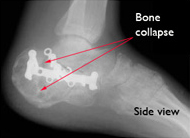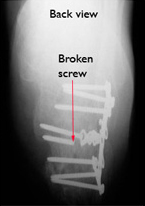Calcaneus Fracture - Heel Bone (Part Three)
Rehabilitation - Reconditioning
Whether you undergo surgery or not, your rehabilitation will be very similar. The time it takes to return to daily activities varies with different types of fractures. This depends on the extent of the damage. Some patients may start to put weight on the leg a few weeks after the injury or surgery, some patients may need to wait 3 or more months before bearing weight on the leg.
Early movement. Many doctors encourage early movement of the foot and ankle at the beginning of the recovery, recuperation period. For example, some patients are instructed to start moving the affected area as soon as their pain allows. Patients who have been operated on are instructed to start moving the affected area as soon as the wound heals.
Physiotherapy. Specific exercises can improve the range of movement of your foot and ankle, and to strengthen the supporting muscles. Although exercises are often painful at first and progress can be difficult, exercises are necessary in order for you to resume normal activities.
Bearing weight on the affected leg. When you start to walk, you may need to use a cane and wear shoes with a collar. It is very important to follow your doctor's instructions on walking on your feet. If you decide to bear weight on your leg too soon, the bone fragments may move out of place and you may need surgery. If you have been operated on, the screws may loosen or break and the bone may be destroyed or collapse. This may not happen the first time you walk on it, but if the bones have not healed and you continue to walk on your leg, the metal plates or screws will break.
 |
 |
| Six months after the operation, the implant failed. Some screws are broken and the calcaneus has collapsed. This patient requires a major operation for reconfiguration, reconstruction of the calcaneus, and now walks with a limp and has limited foot mobility. |
Complications
There is a range of complications of calcaneus fractures. Minor complications include:
- Delayed wound healing
- Irritation of the nerve around the cut
- Irritation of the tendons from screws
- Stiffness of the joint
- Chronic pain
Major complications include:
- Blood clotting or thrombosis
- Non-healing of the wound
- Infection
- Collapse of bones
- Arthritis (with or without surgery)
Smoking affects both bone healing and skin healing, so it's important that you tell your doctor if you smoke. Some surgeons will not perform surgery on a patient who smokes because of the high risk of serious complications. Even without surgery, your bones may take longer to heal if you smoke.
Additional surgery is usually necessary in cases of infection or difficult wound healing. If all methods of problem-solving have failed, amputation may be considered.
Long-Term Outcomes
If your injury is minor, such as a crack, fracture in the bone with minimal muscle damage, you may be able to resume normal activities 3-4 months after the operation. If the fracture is severe it may take 1 to 2 years for complete healing.
Despite the best efforts of the doctor and patient, normal mobility of the foot and ankle is difficult to achieve. A patient who is not very active may tolerate a foot that is not normal. On the other hand, a patient whose work or recreational activities require a lot of walking or climbing mountains will notice much more limitations.
Common Problems
Common problems that may continue after healing include:
Skin irritation. Wearing shoes may irritate the skin or tendons in the affected area.
Gait discrepancies or alterations. In some cases, the arch of the foot is not restored, or the Achilles tendon is not attached at its normal distance from the ankle. Full mobility of the ankle or subtalar joint is rarely achieved in these cases, and this changes the way the patient walks. Patients may have problems walking on uneven floors or hills.
Pain. If the calcaneus remains deformed, the patient may experience continuous pain in the ankle and limited movement. Even if the anatomy of the heel is perfectly restored, the patient may still have discomfort. This may occur due to damage to soft tissues or limitation of the range of motion of the ankle and subtalar joint. Although relatively rare, pain can also be caused by irritation of the plates or screws.
Future Treatments
A simple modification of shoes may help with chronic problems. You may need to wear silicone heel pads, shoe lifts, shoe cups, as well as special shoes with extra depth in the heel area.
Sometimes, another major surgery is necessary. If the bone has healed in a deformed position, or if the subtalar joint becomes arthritic, the joint may need to be fused. The goal of this procedure is to help the calcaneus and talus grow together and form a single bone. Fusion also means that mobility can no longer occur between the two bones.
If the bone is badly deformed, the orthopedic surgeon may attempt to correct some or all of the deformities by fusing the bones together. These operations usually require several months for healing.
Future Directions
Experts are still debating the best treatment method for calcaneus fractures. As usual in every case, no single method works the same for everyone. Patients whose X-rays show a completely normal anatomy of the heel, often still have symptoms of the fracture after an operation. On the other hand, you might see a quite damaged calcaneus on an X-ray, but the patient may have little, if any, symptoms.
There have also been studies comparing the outcomes in patients who were treated non-surgically with fractures and with surgery. Some studies show a considerable benefit of the operation, while other studies show less benefit for certain patients.
Experts continue to work to improve the outcomes of these injuries. Some new developments include:
- Using small cuts – incisions for repositioning and fixing the fracture
- Determining which method is better for treating different types of fractures
- Determining which method works best for treating different patients, for example, smokers or people with diabetes
- Invention of better plates and screws